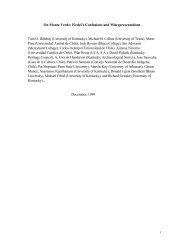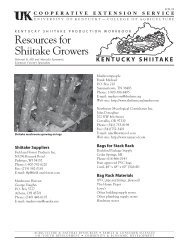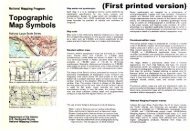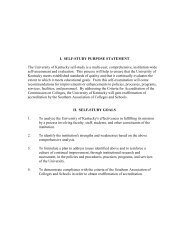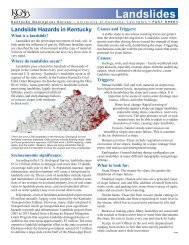Flexible Workplace Solutions for Low-Wage Hourly Workers
Flexible Workplace Solutions for Low-Wage Hourly Workers
Flexible Workplace Solutions for Low-Wage Hourly Workers
Create successful ePaper yourself
Turn your PDF publications into a flip-book with our unique Google optimized e-Paper software.
available at http://www.cvworkingfamilies.org/node/110; Ellen Galinsky, James T. Bond & Kelly Sakai, 2008 National Study of<br />
Employers, FAMILIES & WORK INST. (2008), available at http://familiesandwork.org/site/research/reports/2008nse.pdf [hereinafter<br />
2008 National Study of Employers]; Ellen Galinsky, James T. Bond & E. Jeffrey Hill, A Status Report on Flexibility: Who Has It?<br />
Who Wants It? What Difference Does It Make?, WHEN WORK WORKS (2004), available at http://familiesandwork.org/3w/research/<br />
downloads/status.pdf [hereinafter A Status Report on Flexibility]; J. Landauer, Bottom-line Benefi ts of Work/Life Programs,<br />
HR FOCUS (July 1997); Joe Lineberry & Steve Trumble, The Role of Employee Benefi ts in Enhancing Employee Commitment,<br />
COMPENSATION & BENEFITS MGMT. (Winter 2000).<br />
15<br />
See 2008 National Study of Employers supra note 14; A Status Report on Flexibility, supra note 14.<br />
16<br />
See Lonnie Golden, The Flexibility Gap: Employee Access to Flexibility in Work Schedules, in FLEXIBILITY IN WORKPLACES: EFFECTS<br />
ON WORKERS, WORK ENVIRONMENT AND UNIONS 38–56 (IIRA/ILO 2005); Jennifer Swanberg, Marcie Pitt-Catsouphes & Krista Drescher-<br />
Burke, A Question of Justice: Disparities in Employees’ Access to <strong>Flexible</strong> Schedule Arrangements, 26 J. FAM. ISSUES 866 (2005);<br />
Jennifer Swanberg, <strong>Flexible</strong> Work Arrangements <strong>for</strong> <strong>Low</strong>-<strong>Wage</strong> <strong>Workers</strong>: A Critical Dimension of Job Quality 15–16, presented at<br />
“<strong>Flexible</strong> Work Arrangements and <strong>Low</strong>-<strong>Wage</strong> Work: Creating Opportunity <strong>for</strong> <strong>Low</strong>-<strong>Wage</strong> <strong>Workers</strong>,” Washington, D.C., July 8, 2009.<br />
17<br />
See, e.g., A BETTER BALANCE: THE WORK & FAMILY LEGAL CTR., THE BUSINESS CASE FOR WORKPLACE FLEXIBILITY (Mar. 2008), available at<br />
http://www.abetterbalance.org/web/images/stories/Documents/fairness/factsheets/businesscasewfl ex.pdf; James T. Bond<br />
& Ellen Galinsky, How Can Employers Increase the Productivity and Retention of Entry-Level, <strong>Hourly</strong> Employees?, FAMILIES &<br />
WORK INST. (Nov. 2006), available at http://familiesandwork.org/site/research/reports/brief2.pdf; James T. Bond and Ellen<br />
Galinsky, <strong>Workplace</strong> Flexiblity and <strong>Low</strong>-wage Employees, 2008 NSCW, (2011); LISA DODSON, THE MORAL UNDERGROUND: HOW ORDINARY<br />
AMERICANS SUBVERT AN UNFAIR ECONOMY (The New Press 2009); Charles Grantham, Jim Ware & Jennifer E. Swanberg, <strong>Flexible</strong> Work<br />
Arrangements <strong>for</strong> Nonexempt Employees, WORLDATWORK (2009), http://www.worldatwork.org/waw/adimLink?id=33622; Julia<br />
R. Henly & Susan J. Lambert, Schedule Flexibility and Unpredictability in Retail: Implications <strong>for</strong> Employee Work-Life Outcomes<br />
(July 2010) (working paper, University of Chicago Work Scheduling Study), available at http://www.ssa.uchicago.edu/faculty/<br />
Henly.Lambert.Unpredictability.and.work-life.outcomes.pdf; Susan J. Lambert, Making a Difference <strong>for</strong> <strong>Hourly</strong> Employees, in<br />
WORK-LIFE POLICIES THAT MAKE A REAL DIFFERENCE FOR INDIVIDUALS, FAMILIES, AND COMMUNITIES (Alan Booth & Ann C. Crouter eds., Urban<br />
Institute Press 2009), available at http://harrisschool.uchicago.edu/centers/chppp/pdf/spring08-henly2.pdf. [hereinafter<br />
Making a Difference <strong>for</strong> <strong>Hourly</strong> Employees]; Susan J. Lambert, Passing the Buck: Labor Flexibility Practices that Transfer Risk<br />
onto <strong>Hourly</strong> <strong>Workers</strong>, 61 HUM. REL. 1203 (Sept. 2008) [hereinafter Passing the Buck]; Susan J. Lambert, Anna Haley-Lock & Julia<br />
R. Henly, Work Schedule Flexibility in <strong>Hourly</strong> Jobs: Unanticipated Consequences and Promising Directions (June 2010) (working<br />
paper, Univeristy Chicago Work Scheduling Study), available at http://www.ssa.uchicago.edu/faculty/Lambert.Haley-Lock.Henly.<br />
Unanticipated%20Consequences%20of%20Flexibility%20in%20<strong>Hourly</strong>%20Jobs.7.2010.pdf [hereinafter <strong>Hourly</strong> Jobs]; Susan J.<br />
Lambert & Julia R. Henly, Managers’ Strategies <strong>for</strong> Balancing Business Requirements with Employee Needs: Manager Survey<br />
Results, UNIV. OF CHICAGO, SCH. OF SOC. SERVICE ADMIN. (May 2010), http://news.uchicago.edu/images/assets/pdf/100831.SSA_<br />
work_scheduling.pdf; Jodie Levin-Epstein, Getting Punched: The Job and the Family Clock, CTR. FOR LAW AND SOC. POL’Y (2006),<br />
www.clasp.org/admin/site/publications/fi les/0303.pdf; NAT’L P’SHIP FOR WOMEN & FAMILIES, THE EMPLOYEE CASE FOR FLEIXBILITY IN HOURLY,<br />
LOW-WAGE JOBS, available at http://www.nationalpartnership.org/site/PageServer?pagename=issues_work_Library_workfl ex;<br />
AMY RICHMAN, DIANE BURRUS, LISA BUXBAUM, LAURIE SHANNON, & YOUME YAI, CORP. VOICES FOR WORKING FAMILIES, INNOVATIVE WORKPLACE FLEXIBILITY<br />
OPTIONS FOR HOURLY WORKERS (May 2009), available at http://www.cvworkingfamilies.org/system/fi les/CVWF%20report-FINAL.pdf;<br />
Jennifer E. Swanberg, Jacquelyn B. James, & Sharon P. McKechnie, CitiSales Jobs that Work Study: Can Business Benefi t By<br />
Providing <strong>Workplace</strong> Flexibility to <strong>Hourly</strong> <strong>Workers</strong>?, CITISALES, (n.d.), http://www.citisalesstudy.com/_pdfs/IB3-<strong>Hourly</strong><strong>Workers</strong>.pdf<br />
[hereinafter CitiSales: Business Benefi ts]; Jennifer E. Swanberg, Jacquelyn B. James, Mamta U. Ojha, Mac Werner, & Sharon P.<br />
McKechnie, CitiSales Jobs that Work Study, CITISALES STUDY, (n.d.), http://www.citisalesstudy.com/_pdfs/IB1-<strong>Hourly</strong><strong>Workers</strong>.pdf;<br />
Justina Victor, Evren Esen, Steve Williams, & Nancy R. Lockwood, <strong>Workplace</strong> Flexibility in the 21st Century: Meeting the Needs<br />
of the Changing Work<strong>for</strong>ce (Executive Summary), SOC’Y FOR HUMAN RESOURCE MGMT. (July 2009), http://www.shrm.org/Research/<br />
SurveyFindings/Articles/Documents/09-0425%20<strong>Workplace</strong>%20Flexibility%20Survey%20Report-Executive%20Summary.<br />
pdf; Joan C. Williams & Penelope Huang, Improving Work-Life Fit in <strong>Hourly</strong> Jobs: An Underutilized Cost-cutting Strategy in a<br />
Globalized World, THE CTR. ON WORKLIFE LAW (2011), http://www.worklifelaw.org/pubs/ImprovingWork-LifeFit.pdf; CORP. VOICES FOR<br />
WORKING FAMILIES, supra note 14; WFD CONSULTING, CORP. VOICES FOR WORKING FAMILIES, WORKPLACE FLEXIBILITY FOR LOWER WAGE WORKERS, (Oct.<br />
2006), available at http://www.cvworkingfamilies.org/system/fi les/lowerwagefl exreviewreport.pdf; Williams & Boushey, supra<br />
note 12 at 7–8.<br />
18<br />
Families and Work Institute’s <strong>Workplace</strong> Flexibility and <strong>Low</strong>-wage Employees, which is based on the National Study of the<br />
Changing Work<strong>for</strong>ce (2008), reports that “<strong>Low</strong>-wage employees are signifi cantly less likely (66%) to work regular daytime<br />
schedules than higher-wage employees (79%), though the majority do, and they are much more likely to be paid by the hour<br />
(86% versus 60%). They are also much more likely (32% versus 9%) to have part-time jobs.” <strong>Workplace</strong> Flexibility and <strong>Low</strong>-wage<br />
Employees, 2008 NSCW, supra note 17.<br />
19<br />
One common <strong>for</strong>m of unpredictability <strong>for</strong> part-time and full-time workers is working extra hours with little or no notice. For<br />
full-time workers, this often means working overtime (which is defi ned in the Fair Labor Standards Act as working more than 40<br />
hours per week and requires time and one-half pay). 29 U.S.C. §§ 206(a)(1)(c), 207(a)(1). Part-time workers may also be asked<br />
to work extra hours. The 2008 NSCW asks both part-time and full-time workers (which it defi nes as working more than 35 hours<br />
per week) whether they are asked to work extra hours, capturing both those workers being required to work more than 40 hours<br />
(overtime) and those workers being required to work more hours than they are regularly scheduled to work, but less than 40.<br />
41








